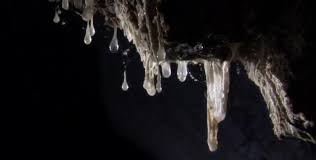(单词翻译:单击)
听力文本
These strange stalactite-like formations are known, rather appropriately, as snottites.
这些奇特的钟乳石状的结构,确切地说,叫做“鼻涕石”
The drops dripping from the ends are sulphuric acid, strong enough to burn skin.
其末端滴落的液滴就是硫酸,酸性强到足以腐蚀皮肤。
The snottites are, in fact, vast colonies of bacteria capable of growing a centimetre a day.
“鼻涕石”其实是大型菌落,每天能长长1厘米。
In this world without sunlight, these bacteria extract energy from the hydrogen sulphide gas.
在这个没有阳光的世界里,这些细菌只能从硫化氢气体中吸收能量
Bacteria like these are known as extremophiles
像这样的细菌被称为嗜极生物
because of their ability to survive in such extreme conditions.
因为它们能在这种极端环境中生存

And these extremophiles play another important role in this cave.
这些嗜极生物还在这个洞中扮演着另一个非常重要的角色。
Surprisingly, they are the basis of a food chain
令人吃惊的是,它们竟然是食物链中的第一环
which supports, amongst other creatures, the larvae of these midges.
用以养活其它生物,例如这些蚋的幼虫。
Villa Luz's ecosystem was certainly very remarkable,
露兹别墅山洞的生态系统的确非同寻常
but cave explorers were soon to make an even more astonishing discovery.
但是洞穴探险家们很快又有了更惊人的发现。
Beneath this arid landscape lies a subterranean wonderland.
谁能想到在这些贫瘠的土地下有一处地下仙境。
视频及简介
洞穴是不受阳光控制的生物栖息地之一,但这并不意味着那里就不存在野生生物。本集节目将深入洞穴内神秘而永恒的黑暗,探索山洞、洞穴和隧洞中未知的地下世界。


